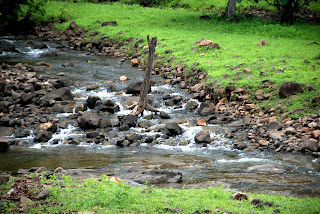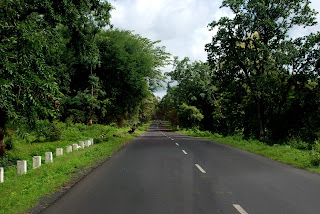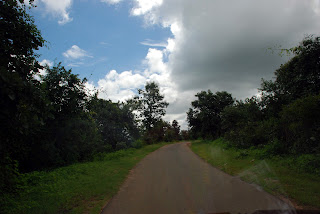When I said I was going to Valparai, not many people registered it. A detailed search on the internet revealed that this place is a one horse town with little or no infrastructure. Few people who had been there claimed it was much more breathtaking than Ooty and its surroundings. That clinched the deal. I had no idea what Ooty or its surroundings look like now but if Valparai is better than someplace and less known, I got to see it.
Valparai is one of the vertices of the tour triangle within Indira Gandhi Wildelife Sanctuary- Parambikulam Wildife santcuary combined reserve forest. The other two are Top Slip and Sethumadai. Of these, Valparai is the least wild and most abused in the name of plantations. Being surrounded by two other reserves (Evarikulam and Chinnar), it was the natural spot to start or end a wildlife tour. When I reached here late afternoon, I found a town that lived up to its 'singular' image...one street, one bank, one ATM, one hotel, one restaurant, one school, one church, one bus station, one police station, one medical store....everything in Valparai is a unique sample....except tea.
Valparai was the tiny and laidback town I expected. It was not exactly a pretty place but was spared of all tourist invasion. It had however completely surrendered to the invasion of tea. The numerous tea estates have but totally put the land under the world's favourite brew shrubs. Some of these estates (one is even named Waterfall Estate although I could not find the eponymous feature anywhere near it) have vast tracts going up and down hill after hill. They make you wonder who the hell would walk all those winding paths? Well there are people to do that; men and women (in their unusual khaki contraptions) who tend to the tea plants, nurture them, prune them, harvest them and basically do everything for your daily cuppa chai. Valparai is for them, a town of tea people.
Overall, Valparai turned out to be an unsure place. It was beautiful, maybe more than Ooty. It was green and fresh, unspoilt by tourist taxis or touts. For serendipity, it had more green bee-eaters and red whiskered bulbuls than crows. But every time I looked at the rows and rows of young tea shrubs that carpeted hill after hill in delightful, different shades of green, I could not help thinking how will the hills look once the shrubs are all gone. Tea replaced pristine woods and drove elephants out. What will replace tea?
Now for the pics:
I was never quite able to find out the name of this species but what you see are not flowers (or, are they?). What look like leaves are looking like flowers but are actually leaves. I could never figure them out but they are all over Valparai and possibly all over the south side of the Palghat gap. They provided me an apt welcome to Valparai that confused me as much as this plant.
Those flowery leaves were not the first ones that welcomed me. In fact thew welcome was not all auspicious. As I negotiated the 42 odd hairpins on my climb to Valparai, I came across these huge clumps of bamboo in gregarious flowering. It is quite natural for each bamboo plant of the same cluster to flower at the same time as the others. Entire length of bamboo divert all their efforts into flowering which is followed by fruiting. Bamboo dies after fruiting. The collective blooming of bamboo in an orgiastic explosion seems like one last hurrah before the end. Rodent population increases drastically thanks to the over supply of bamboo fruit. As bamboo dies, building material becomes scarce. Harvested grain is targeted by the increased population of rodents. Disease, famine and desolation follows. Bamboo is the most sought after weed but becomes the bane of mankind when it goes. Thank you wikipedia! So much for good omens! Nevertheless this glorious golden hue presented a nice photo op.

Valparai had few interesting detours. One of them was the Nirar dam. In fact there are 4 deep dams in the immediate vicinity of Valparai. Nirar perhaps offers the best view of the surroundings. My objects of interest are the tall peaks in the background. If my sense of geography and Eicher maps are correct, one of those peaks is the Anaimudi - the tallest peak in India south of Himalayas
Most of the 'attractions' around Valparai can be finished off in a day. They do not offer any more than what you expect from a place about which no tourism brochure exists. But there was an interesting detour from Valparai that I was primarily interested in. Having seen some stunning pictures of Athirampally waterfalls in a chain mail, I was tempted to see it for real. The only problem was the 80km drive into Kerala from Valparai. This road which connects Pollachi and Chalakudi was not exactly a favoured route for many. The only fuel station in this region was in Valparai. There is absolutely no civilization after crossing the Kerala check post and a terrible excuse for a road. The forest ranger at Kerala check post spoke swift Tamil-Malayalam without favouring either language or accent. I could catch only three words in English and they were enough to agitate the mickeys in me :"5'o clock, dangerous, elephants"! There is certain romanticism about watching a tiger or leopard in the wild. There is none with elephants. They move in herds and have scant regard for traffic rules. Heaven hath no fury as a male elephant in must. But there were some bonuses. 40 km into the forest, we chanced upon the Paringalkuthu reservoir held back by yet another dam high up in the hills. The scene more than made up for the bone jarring drive:
There are times I am suckered into believing chain mails. I was stupid enough to fall for a chain mail with pix of Iguazu falls (Argentina) claiming to be Athirampally Falls in Kerala. The pics were so good that I planned the whole Valparai thing just to see the falls. The falls were not so bad and would have been even more spectacular right after monsoon. The real dampener was not those barren rocks but the realization that I was suckered into driving 80 km on horrible jungle roads for 6 hours through elephant territory to see something less spectacular. To add insult to injury, this place was embellished with all the tourist trappings and hordes of travellers that I specifically chose to avoid in this trip. I did not even bother to walk down the pathways leading to the falls. A brief stopover and a photo for memories and we were off to Chalakudy. There was no way we were going back the way we came. Rather we chose to do a long roundabout via Thrissur, Palakkad and Pollachi back to our hotel in Valparai.
The road to Athirampally did not disappoint us completely. There were brief stretches of wonderful asphalt and picture postcard perfect scenes. We stopped at this lovely spot by an old bridge. There were lot of empty beer bottles in spite of which, we found peace here. A perfect watering hole for the youngsters of Kerala to spend an lazy afternoon with beer and buddies, there were none of them that Tuesday afternoon.
The only disappointment was that we were late for our date with Athirampally and eager to get off the jungles before 5PM. We spent just the amount of time to enable me a nice snap for memories.
Back to Valparai. It was time to wind up things here with all that tea. The plantations were not all that drab. They provided some interesting patterns.
Early morning sun bouncing off the young shoots was a treat to the eyes. For a moment, I did not bother with doomsday imagery of Valparai.
Tea plants are a pretty sight I must admit. They made me hungry each time I went close. They resembled a platter of garden fresh salad greens.
I had no idea what was the scale for. Probably a ready reckoner for harvesting. By the look of it, tea plants have a limited height. No wonder the hills resembled billiards table tops. I would have loved tall pines and oaks. But the carpet-like foliage of tea was not bad either. If only someone saw sense in conservation and balancing commercial interests with natural habitation.
I was probably blabbering. We left Valparai with mixed feelings. My wife liked the tea gardens. So did I but I can never cease to wonder the irony of this beauty in the backdrop of all the natural forestry that was replaced. We still had four lazy days to spend and had not planned anything beyond Valparai. A useful travel guidebook helped us find another "unspoilt" hill town not far off. With no advance bookings or prior enquiries, we decided to try it out. We reached Neliyampathy the same evening we left Valparai.
NELIYAMPATHY
If Valparai is a one horse town, Neliyampathy needs a new ephitet. There is hardly a town or a main arterial. Just a collection of huts and vague buildings here and there.
- There were two main differences from Valparai. Coffee replaced tea as the flavour of planters, though there were enough tea plantations in Neliyampathy to recreate that Valparai feeling.
- The rain forest was mercifully spared with some better planning of resources.
Neliyampathy is in Palakkad district high up in the hills, as high as Valparai. In fact Neliyampathy, Valparai, Parambikulam and TopSlip all fall in the same biosphere. As the crow flies, Neliyampathy, at the northern fringe of Parambukulam is 80 km from Valparai that falls between Parambikulam and Evarikulam. So both places share the same forestry although Valparai is almost bereft of forest. There were some tourist brochures for Neliyampathy even though it was smaller and almost unknown in comparision to Valparai. For some reason it featured oranges on the cover page. I read that Neliyampathy was famous for its oranges. I did not find any orange tree. Worse, the locals gave me a weird look when I mentioned oranges. The coffee plantations had sprinklers that were timed to act at an appointed hour. I was fortunately close to one crop as the rain dance commenced. It was no less interesting than a musical fountain.
There were three resorts up the hills and one of them was outrageously beyond my budget. The one in the mid range offered the best value. Despite being isolated in a remote part of Neliyampathy that was frequented by gaurs and wild boars, the place offered all the jungle experience we looked forward to. It was actually a mixed plantation of coffee, pepper and other cash crops amidst unspoilt jungle. The nearest civilization was 4 km away by a torturous road.
Within the resort premises, I found my prized catch. A Malabar Giant Squirrel. I found it on my walk around the estate. I would have missed it had the big fella kept quiet about his business of wooing his lady. Instead he made a big racket that echoed all over. I found him on a tree about 100 metres from my cottage.
The search for the squirrel turned into bird watching. What looked like a hoopoe is some kind of woodpecker that revealed itself with the loud hammering noise it made pecking on the trunks of trees. I am not sure if it is a woodpecker but it did not shy sway from the photo.
I thought I found an Oriole that belonged to this region but the little bird turned out to be a Scarlet Minivet. Only it was not scarlet in shade. It is the male that sports scarlet feathers, This one is the female of the species. Unfortunately the male's photo is not good enough to make it to this collection. This pic summed up the pleasant experience I had at Neliyampathy.
Neliyampathy was a serendipitous discovery. Despite the fact that the main attractions were closed thanks to the ongoing tiger census, the resort was provided us all the thrills. Not only were they happy to accommodate us on short notice but the estate proved to be a lovely hunting ground for bird photography.
One day, I might post another update to Neliyampathy with better pictures and more ground covered. Till then, I keep dreaming.











































































































